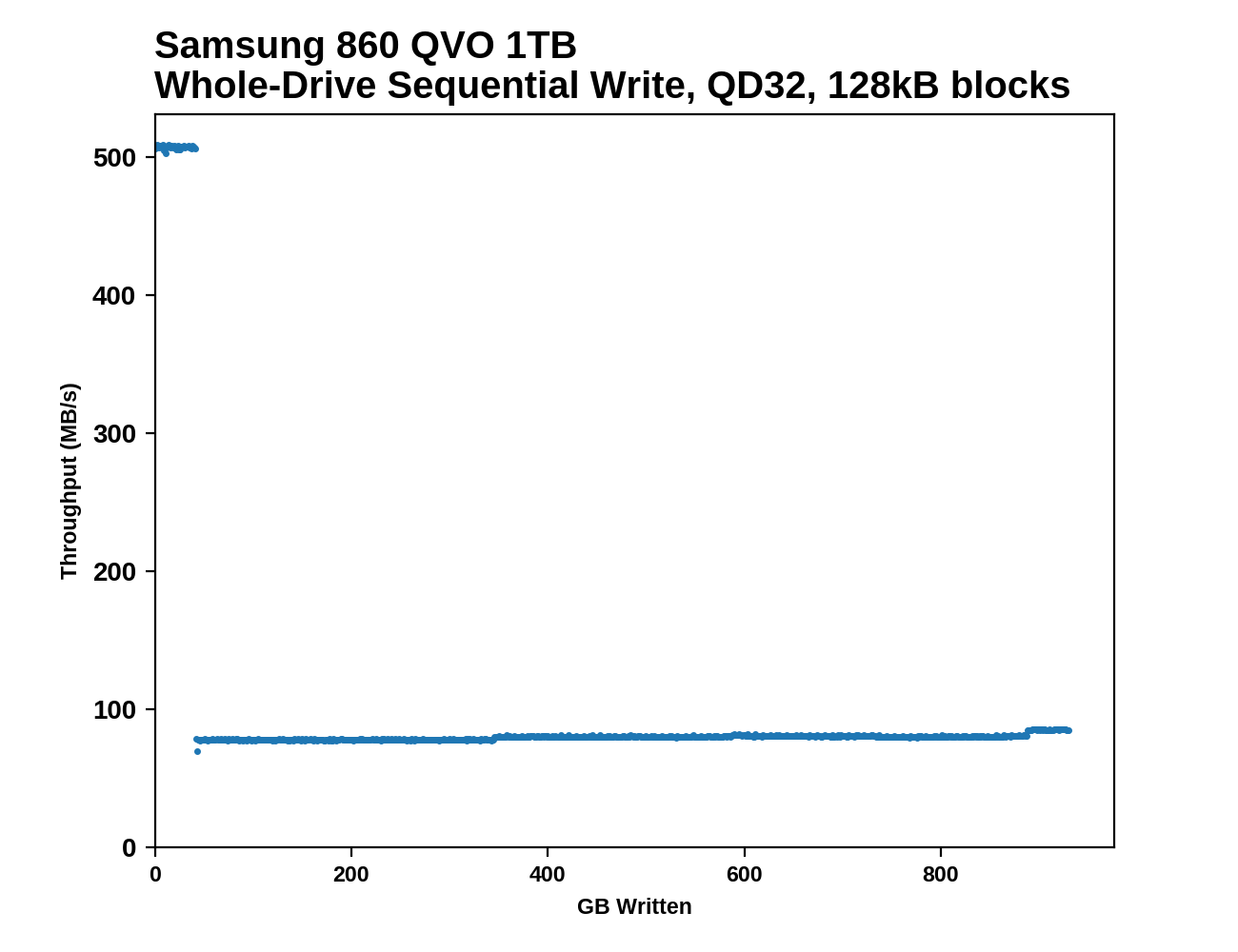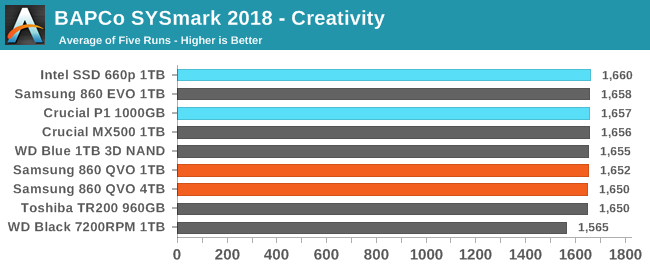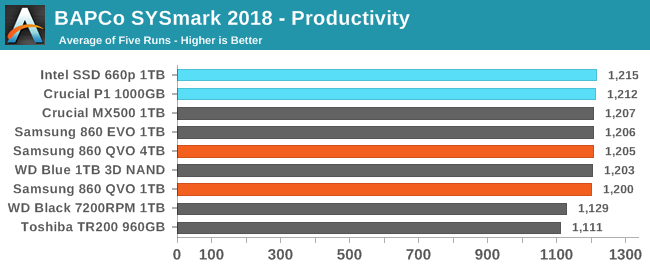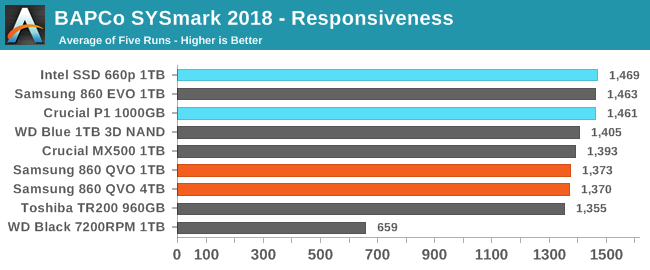The Samsung 860 QVO (1TB, 4TB) SSD Review: First Consumer SATA QLC
by Billy Tallis on November 27, 2018 11:20 AM ESTWhole-Drive Fill: Testing SLC Cache Size
This test starts with a freshly-erased drive and fills it with 128kB sequential writes at queue depth 32, recording the write speed for each 1GB segment. This test is not representative of any ordinary client/consumer usage pattern, but it does allow us to observe transitions in the drive's behavior as it fills up. This can allow us to estimate the size of any SLC write cache, and get a sense for how much performance remains on the rare occasions where real-world usage keeps writing data after filling the cache. Samsung's official specifications are:
| Samsung 860 QVO Secondary Specifications | |||||
| Capacity | 1 TB | 2 TB | 4 TB | ||
| SLC Cache Size |
Min | 6 GB | 6 GB | 6 GB | |
| Max | 42 GB | 78 GB | 78 GB | ||
| Sequential Write |
SLC Cache | 520 MB/s | |||
| QLC | 80 MB/s | 160 MB/s | 160 MB/s | ||
Our results show the following:
 |
|||||||||
The Samsung 860 QVOs run out of SLC cache right on schedule, at 42 GB for the 1TB model and 78 GB for the 4TB. After that, they are both slow and very steady for the rest of the test.
 |
|||||||||
| Average Throughput for last 16 GB | Overall Average Throughput | ||||||||
The 1TB 860 QVO falls below the sequential write speed of a 1TB hard drive once the SLC cache runs out, but the 4TB model is able to sustain twice the write speed and remains ahead of not just the hard drive's speed, but also some of the slower TLC drives.
BAPCo SYSmark 2018
BAPCo's SYSmark 2018 is an application-based benchmark that uses real-world applications to replay usage patterns of business users, with subscores for productivity, creativity and responsiveness. Scores represnt overall system performance and are calibrated against a reference system that is defined to score 1000 in each of the scenarios. A score of, say, 2000, would imply that the system under test is twice as fast as the reference system.
SYSmark scores are based on total application response time as seen by the user, including not only storage latency but time spent by the processor. This means there's a limit to how much a storage improvement could possibly increase scores, because the SSD is only in use for a small fraction of the total test duration. This is a significant difference from our ATSB tests where only the storage portion of the workload is replicated and disk idle times are cut short to a maximum of 25ms.
| AnandTech SYSmark SSD Testbed | |
| CPU | Intel Core i5-7400 |
| Motherboard | ASUS PRIME Z270-A |
| Chipset | Intel Z270 |
| Memory | 2x 8GB Corsair Vengeance DDR4-2400 CL17 |
| Case | In Win C583 |
| Power Supply | Cooler Master G550M |
| OS | Windows 10 64-bit, version 1803 |
Our SSD testing with SYSmark uses a different test system than the rest of our SSD tests. This machine is set up to measure total system power consumption rather than just the drive's power.



The 860 QVO isn't any slower for compute-heavy interactive tasks than the mainstream SATA SSDs, and even on the more I/O-bound Responsiveness test the 860 QVO is ahead of the DRAMless TLC drive and not far behind the Crucial MX500.
Energy Use
The SYSmark energy usage scores measure total system power consumption, excluding the display. Our SYSmark test system idles at around 26 W and peaks at over 60 W measured at the wall during the benchmark run. SATA SSDs seldom exceed 5 W and idle at a fraction of a watt, and the SSDs spend most of the test idle. This means the energy usage scores will inevitably be very close. A typical notebook system will tend to be better optimized for power efficiency than this desktop system, so the SSD would account for a much larger portion of the total and the score difference between SSDs would be more noticeable.

The Samsung 860 QVO's energy usage during SYSmark is not a problem at all, with it using slightly less energy than the mainstream SATA TLC drives.










109 Comments
View All Comments
Lolimaster - Thursday, November 29, 2018 - link
HDD's sweet spot for manufacturers is the 4TB and up, they can't really make them cheaper than $40-50 no matter the size, it got tons of physical moving parts, a big chunk of well crafted aluminum, special sealing, etc vs an SSD that is just nand and a plastic casing before at least you got a thin aluminum case.Glaurung - Tuesday, November 27, 2018 - link
Spinning drives aren't going away - capacities are still going up and spinning drives are still the best deal for extremely high capacity storage - like NAS and datacentre storage. That's unlikely to change any time soon. But the amount of storage that you're realistically going to want inside your computer? It's now affordable to go all SSD for your local internal storage.But storage inside your laptop has until now been a case of needing two drives, a fast SSD to boot off of and a slow HDD for your data. Or else pay a ton for a high capacity SSD, or make do with a small drive
Dr. Swag - Tuesday, November 27, 2018 - link
Selling an inferior SSD to the 860 evo for more! What a great ideaPaoDeTech - Tuesday, November 27, 2018 - link
Lower cost (QLC) higher capacity SSDs are very welcome. Is as simple as that. I read an interesting study that basically concludes that an SSD lifespan is usually limited by age not total writes. Interesting. Can anybody confirm or deny?hojnikb - Tuesday, November 27, 2018 - link
Not really. SSDs don't tend to die of old age or exhausted endurance (not in client workloads anyway) but rather random controller faulires and firmwar bugs.One considuration with such flash is data retention. As these are fairly large drives, they will be used for storage and hence this can become an issue.
PaoDeTech - Tuesday, November 27, 2018 - link
Here's the article: https://www.zdnet.com/article/ssd-reliability-in-t...hojnikb - Wednesday, November 28, 2018 - link
Quickly skimming the article, it does seem to suggest, that age has an effect on raw bit errors. What it doesn't include (not that i can find) is wheter drives were the same model and manufacturer.Older drives could be of inferior controllers and weaker firmware design which can't cope with bit errors as well.
spkay31 - Tuesday, November 27, 2018 - link
Personally I think the Intel 660p NVMe SSD's offer a very nice price performance tradeoff when on sale. Yesterday an Intel 660p 1TB drive was on sale for $130. At around 1800Mbps it's ~ 3.5X faster than a SATA ssd and about 45% cheaper than a Samsung 970 EVO 1TB NVMe drive. OK, so it's 1800Mbps vs 3200Mbps but again for my uses that is certainly excellent speed improvement from a SATA ssd and I'm willing to accept some of the other shortcomings of QLC. My experience is that QLC is already a very reasonable value proposition for many applications.JoeyJoJo123 - Tuesday, November 27, 2018 - link
While I have nothing against the Intel 660p, not QLC, and I very much welcome these technologies, even considering black friday """deals""", I still don't think it has become price competitive (yet).I purchased an 860 EVO 1TB for $127 ($127 after tax/shipping), and then later an MX500 2TB for $209 ($229 after tax/shipping). (Bought the 860 EVO 1TB since the 2TB was $299 and therefore much more expensive in $/GB, and because I hadn't seen anything better by the time it was Saturday, but CyberMonday on Amazon brought the $209 MX500. I may or may not return the 860 EVO.)
Both of these drives are 3D TLC based, and still have their marginal sustained read/write advantages over 3D QLC. Given the (roughly) equivalent price between a 1TB 860 EVO 1TB and Intel 660p 1TB, I don't think it's unfair to say that the 860 EVO should be every customer's pick every single time (again, given these """deal""" prices).
As always, it'll take some time before newer technologies drop in prices and mature in overall value. I'm sure it'll happen for QLC drives, as they did with MLC and TLC before them, but it just hasn't happened quite yet.
Impulses - Thursday, November 29, 2018 - link
Wait what? The 2TB MX500 hit $209 this year? Was it a flash sale or something? I had price alerts set on it, the 860 EVO, and the WD Blue/SanDisk Ultra and the cheapest I saw for a 2TB was $255... Granted I was mostly looking at Amazon, where'd you score that deal?